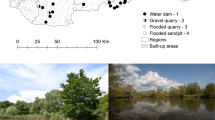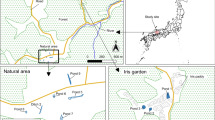Abstract
This study aimed to identify ascidians in the coastal area of Chabahar Bay and assess their biodiversity in three stations (University, Tiss, Lipar) and four seasons for the first time. Sampling was carried out in the intertidal zone from July 2019 to May 2020, and samples were counted using the quadrate method. After narcotizing (in menthol crystal solution) and fixing (in formaldehyde solution), ascidians were identified using identification keys. The assessment of ascidians in Chabahar Bay led to the identification of Phallusia nigra, Cnemidocarpa sp., and Styela plicata. Results showed that P. nigra had the highest density in Lipar station (6.01 ± 0.72 individuals m−2) and during winter (6.65 ± 0.87). On the other hand, Cnemidocarpa sp. had the highest density in the University station (6.93 ± 0.84) and during fall (6.03 ± 0.96). The dispersion index showed that all ascidians identified in Chabahar Bay had an aggregated dispersion pattern. Moreover, the sustainability index showed that P. nigra and Cnemidocarpa sp. are more sustainable than Styela plicata. Assessment of each species in various seasons and stations showed that their abundance fluctuates based on their biology and effective physical factors. On the other hand, the assessment of their biodiversity using usual biodiversity indices (Shannon-Weiner index, the Simpson index, and Margalef index) showed a significant effect (P < 0.05) of seasons and stations on these indices. The discernible impact of seasonal variations becomes more pronounced, underscoring the dynamic fluctuations in ascidian biodiversity within Chabahar Bay over the course of a year.






Similar content being viewed by others
Data and Materials Availability
The data and materials used in this research are presented with full transparency. The author is committed to providing a clear and comprehensive account of the research process, methodologies, and results. Any additional information or clarification regarding the data and materials can be made available upon request. Openness and transparency are integral aspects of this study to facilitate the understanding and reproducibility of the research.
Code Availability
The present study did not involve the development or utilization of specific code. Therefore, there is no associated code, and the research findings are not dependent on any proprietary or custom code. If future work involves code development, its availability will be duly communicated.
References
Aldred, N., and A.S. Clare. 2014. Mini-review: impact and dynamics of surface fouling by solitary and compound ascidians. Biofouling 30: 259–270.
Ali Haj, H., and M. Tamilselvi. 2016. Ascidians in coastal water: a comprehensive inventory of Ascidian Fauna from the Indian Coast. Berlin: Springer.
Amini Yekta, F., Agah, H., Saleh, A., and Jalili, M. 2013. Distribution of subtidal molluscs in Chabahar Bay and surrounding waters (Iran) with emphasis on the effect of environmental factors. In INOC-IIUM-International Conference on “Oceanography & Sustainable Marine Production: A Challenge of Managing Marine Resources under Climate Change, ICOSMaP”, Kuantan-Malaysia, pp.178–182. Accessed 28–30 October 2013.
Arasaki, E., P. Muniz, and A.M.S. Pires-Vanin. 2004. A functional analysis of the benthic macrofauna of the São Sebastião Channel (Southeastern Brazil). Marine Ecology 25: 249–263.
Asghari, S., Ahmadi, M., Mohammadizadeh, F., Ebrahimi, M., Ejlali, K., Aghajari, S., and Akbarzadeh, G.A. 2011. A survey of diversity and density of gastropoda before and after summer monsoon in the Iranian coasts of the Oman Sea.
Casertano, M., M. Menna, and C. Imperatore. 2020. The ascidian-derived metabolites with antimicrobial properties. Antibiotics 9: 510.
Chen, L., J.-S. Hu, J.-L. Xu, C.-L. Shao, and G.-Y. Wang. 2018. Biological and chemical diversity of ascidian-associated microorganisms. Marine Drugs 16: 362.
de Barros, R.C., R.M. da Rocha, and M.R. Pie. 2009a. Human-mediated global dispersion of Styela plicata (Tunicata, Ascidiacea). Aquatic Invasions 4: 45–57. https://doi.org/10.3391/ai.2009.4.1.4.
Ghasemi, S., M. Zakaria, and N. Mola Hoveizeh. 2011. Abundance of molluscs (gastropods) at mangrove forests of Iran. Journal of American Science 7 (1): 660–669.
Goodbody, I. 1962. The biology of Ascidia nigra (Savigny). I. Survival and mortality in an adult population. The Biological Bulletin 122: 40–51.
Izquierdo Muñoz, A., Díaz Valdes, M., and Ramos-Esplá, A.A. 2009. Recent non-indigenous ascidians in the Mediterranean Sea.
Karaiskou, A., B.J. Swalla, Y. Sasakura, and J.P. Chambon. 2015. Metamorphosis in solitary ascidians. Genesis 53: 34–47.
Kazemian, M., Delfiyeh, P., and Khodadadi, M. 2009. Study on the frequency of bivalves and gastropods in the Tis rocky coast of the Chabahar Gulf.
Kondilatos, G., M. Corsini-Foka, and M.A. Pancucci-Papadopoulou. 2010. Occurrence of the first non-indigenous ascidian Phallusia nigra Savigny, 1816 (Tunicata: Ascidiacea) in greek waters. Aquatic Invasions 5: 181–184.
Kor, K., A. Ghazilou, and H. Ershadifar. 2020. Microplastic pollution in the littoral sediments of the northern part of the Oman Sea. Marine Pollution Bulletin 155: 111166.
Lins, D.M., J.R.P. de Marco, A.F. Andrade, and R.M. Rocha. 2018. Predicting global ascidian invasions. Diversity and Distributions 24: 692–704.
Momtazi, F., and Zarei, R. 2020. Assessment of Amphipoda communities in Chabahar Bay using species richness and Taxonomic distinctness indices. Journal of the Persian Gulf 9(34): 47–53. Issue of Second International Conference on Oceanography for West Asia (RCOWA) 2020.
Moradmand, M., and Sari, A. 2007. Littoral hermit crabs (Decapoda: Anomura: Paguroidea) from the Gulf of Oman, Iran.
Oerke, E.C., A. Meier, H.W. Dehne, M. Sulyok, R. Krska, and U. Steiner. 2010. Spatial variability of fusarium head blight pathogens and associated mycotoxins in wheat crops. Plant Pathology 59: 671–682.
Palanisamy, S.K., N. Rajendran, and A. Marino. 2017. Natural products diversity of marine ascidians (Tunicates; Ascidiacea) and successful drugs in clinical development. Natural Products and Bioprospecting 7: 1–111.
Pineda, M.C., S. López-Legentil, and X. Turon. 2011. The whereabouts of an ancient wanderer: global phylogeography of the solitary ascidian Styela plicata. PLoS ONE 6: e25495.
Pineda, M.C., X. Turon, and S. López-Legentil. 2012. Stress levels over time in the introduced ascidian Styela plicata: the effects of temperature and salinity variations on hsp70 gene expression. Cell Stress and Chaperones 17: 435–444. https://doi.org/10.1007/s12192-012-0321-y.
Ramar, M., B.K. Khan, and Ali Haj. 2018. Spatial and temporal variations in the occurrence of solitary ascidian Phallusia nigra Savigny, 1816 in Thoothukudi (South East Coast) and Vizhinjam (South West Coast) of India. Science and Humanities 4: 21.
Rius, M., X. Turon, and D.J. Marshall. 2009. Non-lethal effects of an invasive species in the marine environment: the importance of early life-history stages. Oecologia 159: 873–882.
Rius, M., G.M. Branch, C.L. Griffiths, and X. Turon. 2010. Larval settlement behaviour in six gregarious ascidians in relation to adult distribution. Marine Ecology Progress Series 418: 151–163.
Rocha, R.M., and S.B. Faria. 2005. Ascidians at Currais Islands, Paraná, Brazil: taxonomy and distribution. Biota Neotropica 5 (2): 20.
Sadeghi, P., and M. Loghmani. 2010. First record of Acanthopleura vaillantii (Mollusca: Polyplacophora) from Iran-Chabahar Bay in the Oman Sea. Marine Biodiversity Records 3 (1): e7.
Segelken-Voigt, A., A. Bracher, B. Dorschel, J. Gutt, W. Huneke, H. Link, and D. Piepenburg. 2016. Spatial distribution patterns of ascidians (Ascidiacea: Tunicata) on the continental shelves off the northern Antarctic Peninsula. Polar Biology. https://doi.org/10.1007/s00300-016-1909-y.
Shahdadi, A., and A. Sari. 2011. Chthamalid barnacles (Cirripedia: Thoracica) of the Persian Gulf and Gulf of Oman, Iran. Journal of the Marine Biological Association of the United Kingdom 91 (3): 745–753.
Shenkar, N. 2012. Ascidian (Chordata, Ascidiacea) diversity in the Red Sea. Marine Biodiversity 42: 459–469.
Shenkar, N., and B.J. Swalla. 2011. Global diversity of Ascidiacea. PLoS ONE 6: e20657.
Shenkar, N., Y. Zeldman, and Y. Loya. 2008. Ascidian recruitment patterns on an artificial reef in Eilat (Red Sea). Biofouling 24: 119–128.
Taverna, A., C. Lagger, T. Maggioni, P. Reyna, G. Lovrich, and M. Tatian. 2018. Ascidian distribution provides new insights to help define the biogeographic provinces in the South American Region. Polar Biology 41: 1123–1131.
Thiyagarajan, V., and P.-Y. Qian. 2003. Effect of temperature, salinity, and delayed attachment on development of the solitary ascidian Styela plicata (Lesueur). Journal of Experimental Marine Biology and Ecology 290: 133–146.
Turon, X., and M. Becerro. 1992. Growth and survival of several ascidian species from the northwestern Mediterranean. Marine Ecology Progress Series 82: 235–247.
Vandepas, L.E., L.M. Oliveira, S.S. Lee, E. Hirose, R.M. Rocha, and B.J. Swalla. 2015. Biogeography of Phallusia nigra: is it really black and white? The Biological Bulletin 228: 52–64.
Venkatesan, M., et al. 2020. Bioactive metabolites from marine ascidians: future treatment for autism spectrum disorder. In Personalized food intervention and therapy for autism spectrum disorder management. Advances in neurobiology, vol. 24, ed. M. Essa and M. Qoronfleh. Cham: Springer.
Villalobos, S.M., G. Lambert, N. Noa Shenkar, and S. López-Legentil. 2017. Distribution and population dynamics of key ascidians in North Carolina harbors and marinas. Aquatic Invasions 12 (4): 447–458. https://doi.org/10.3391/ai.2017.12.4.03.
Yakovis, E.L., A.V. Artemieva, and M.V. Fokin. 2004. Spatial pattern indicates an influence of barnacle and ascidian aggregations on the surrounding benthic assemblage. Journal of Experimental Marine Biology and Ecology 309: 155–172.
Yazdani, M., Taheri, M., Sanjani, M.S., and Seyfabadi, J. 2009 New observation of two species, Thalamita admete and Thalamita prymna (Decapoda: Portunidae), from Chabahar Bay (Gulf of Oman).
Zardus, J.D., B.T. Nedved, Y. Huang, C. Tran, and M.G. Hadfield. 2008. Microbial biofilms facilitate adhesion in biofouling invertebrates. The Biological Bulletin 214: 91–98.
Acknowledgements
The author expresses sincere gratitude to all individuals who contributed to the species identification process and generously provided valuable reprints. Their assistance and expertise significantly enriched the quality of this study. The collaborative efforts and support from these individuals are greatly appreciated.
Funding
This research did not receive any specific grant from funding agencies in the public, commercial, or not-for-profit sectors. The study was conducted independently, and the author acknowledges that no external financial support was provided for the research.
Author information
Authors and Affiliations
Contributions
The present research statement does not include specific details about individual contributions to the study. If there were multiple contributors, their respective roles and contributions would be delineated in this section. In the absence of such details, it is implied that the study is the work of a single author or that the specific contributions are not explicitly outlined in this context.
Corresponding author
Ethics declarations
Conflict of interest
The author declares that she has no known competing financial interests or personal relationships that could have appeared to influence the work reported in this paper. The research and its findings are presented with full transparency and without any potential conflicts of interest.
Ethical Approval
The present study statement indicates that ethics approval was not applicable to the research. This implies that the nature of the study did not involve human subjects, animals, or any other ethical considerations that would necessitate approval from an ethics review board. If ethical considerations were involved, details of the approval process and compliance would typically be provided in this section.
Consent to Participate
The statement indicates that there is no applicable consent to participate, suggesting that the study did not involve human subjects or participants requiring explicit consent. In studies involving human participants, this section would typically outline the informed consent process and detail how participants were informed about the research and agreed to participate.
Consent for Publication
The statement implies that there is no specific consent for publication mentioned in the context of the study. This suggests that the research did not involve any individuals whose explicit consent for the publication of data or findings would be required. In situations where individual consent is necessary, this section would typically provide details about the consent process and how it aligns with ethical standards.
Additional information
Publisher's Note
Springer Nature remains neutral with regard to jurisdictional claims in published maps and institutional affiliations.
Rights and permissions
Springer Nature or its licensor (e.g. a society or other partner) holds exclusive rights to this article under a publishing agreement with the author(s) or other rightsholder(s); author self-archiving of the accepted manuscript version of this article is solely governed by the terms of such publishing agreement and applicable law.
About this article
Cite this article
Khaleghi, M. The Assessment of Spatial and Temporal Changes of Ascidians in the Intertidal Zone of Chabahar Bay, the Gulf of Oman. Proc Zool Soc 77, 173–182 (2024). https://doi.org/10.1007/s12595-024-00519-3
Received:
Revised:
Accepted:
Published:
Issue Date:
DOI: https://doi.org/10.1007/s12595-024-00519-3




